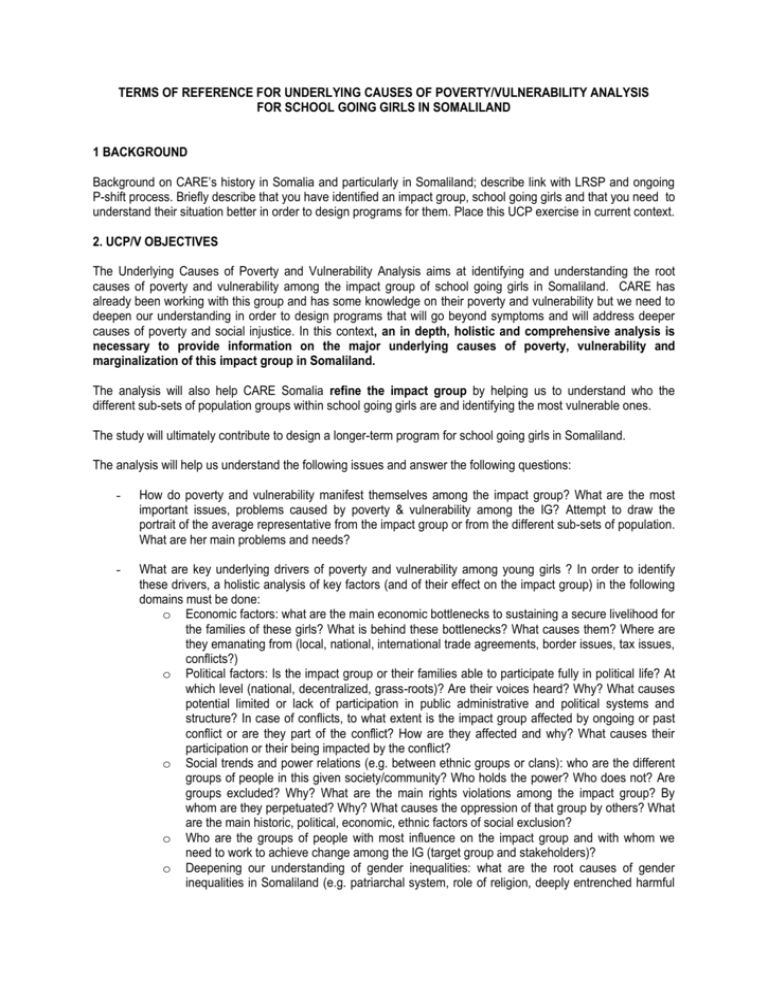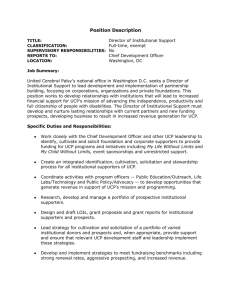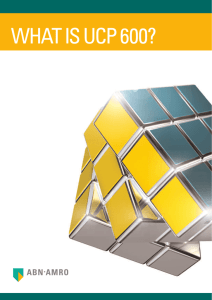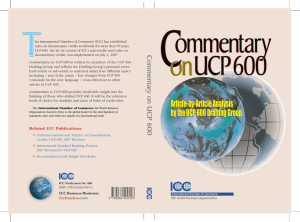Somalia TOR, UCP, V Analysis - P
advertisement

TERMS OF REFERENCE FOR UNDERLYING CAUSES OF POVERTY/VULNERABILITY ANALYSIS FOR SCHOOL GOING GIRLS IN SOMALILAND 1 BACKGROUND Background on CARE’s history in Somalia and particularly in Somaliland; describe link with LRSP and ongoing P-shift process. Briefly describe that you have identified an impact group, school going girls and that you need to understand their situation better in order to design programs for them. Place this UCP exercise in current context. 2. UCP/V OBJECTIVES The Underlying Causes of Poverty and Vulnerability Analysis aims at identifying and understanding the root causes of poverty and vulnerability among the impact group of school going girls in Somaliland. CARE has already been working with this group and has some knowledge on their poverty and vulnerability but we need to deepen our understanding in order to design programs that will go beyond symptoms and will address deeper causes of poverty and social injustice. In this context, an in depth, holistic and comprehensive analysis is necessary to provide information on the major underlying causes of poverty, vulnerability and marginalization of this impact group in Somaliland. The analysis will also help CARE Somalia refine the impact group by helping us to understand who the different sub-sets of population groups within school going girls are and identifying the most vulnerable ones. The study will ultimately contribute to design a longer-term program for school going girls in Somaliland. The analysis will help us understand the following issues and answer the following questions: - How do poverty and vulnerability manifest themselves among the impact group? What are the most important issues, problems caused by poverty & vulnerability among the IG? Attempt to draw the portrait of the average representative from the impact group or from the different sub-sets of population. What are her main problems and needs? - What are key underlying drivers of poverty and vulnerability among young girls ? In order to identify these drivers, a holistic analysis of key factors (and of their effect on the impact group) in the following domains must be done: o Economic factors: what are the main economic bottlenecks to sustaining a secure livelihood for the families of these girls? What is behind these bottlenecks? What causes them? Where are they emanating from (local, national, international trade agreements, border issues, tax issues, conflicts?) o Political factors: Is the impact group or their families able to participate fully in political life? At which level (national, decentralized, grass-roots)? Are their voices heard? Why? What causes potential limited or lack of participation in public administrative and political systems and structure? In case of conflicts, to what extent is the impact group affected by ongoing or past conflict or are they part of the conflict? How are they affected and why? What causes their participation or their being impacted by the conflict? o Social trends and power relations (e.g. between ethnic groups or clans): who are the different groups of people in this given society/community? Who holds the power? Who does not? Are groups excluded? Why? What are the main rights violations among the impact group? By whom are they perpetuated? Why? What causes the oppression of that group by others? What are the main historic, political, economic, ethnic factors of social exclusion? o Who are the groups of people with most influence on the impact group and with whom we need to work to achieve change among the IG (target group and stakeholders)? o Deepening our understanding of gender inequalities: what are the root causes of gender inequalities in Somaliland (e.g. patriarchal system, role of religion, deeply entrenched harmful cultural practices like FGM, early marriages, polygamy, etc)? How does it affect our impact group? - How has the situation of the group evolved over the last 10-20 years? What has improved? What got worse and what were the main drivers for these positive and negative changes? - What are the dynamics, links and inter-relationships between all the above identified drivers? How do they influence one another? - Based on the above, what are main domains of change on which a program targeting this IG should be focusing? (attempt to formulate a first draft of a Theory of Change). 3. STREAMLINING OBJECTIVES We need to recognize that we are not starting from scratch and that we already have existing projects in this region that may or may not be working together but that probably already can contribute to the analysis. CARE Somalia realizes that there is an urgent need to integrate the projects in this region by making them work together gradually around one same impact group under a program approach. In this context, we also expect from the consultant to do a review of existing projects with the objective to determine the extent to which they address the identified underlying causes of poverty and vulnerability. This will allow CARE Somalia to streamline and integrate all projects being implemented in the region for complimentarity and generating synergy while the program continues to be designed. 4. SUGGESTED METHODOLOGY FOR UCP/V ANALYSIS 4.1. PRODUCING A LIST OF UCP/V Acknowledging that CARE has been working in Somalia and in this region and with this impact group for some time, extracting the existing knowledge on UCP/Vs among CARE staff and partners is an important first step. That could be done in workshop form or through interviews or focus group discussions with staff and partners as well as review existing documents produced by CARE. Simultaneously, a review of secondary data and documents from others should be done to compliment the long list. Because of the situation in Somalia and the absence of a strong government, little literature can probably be found from government sources but other INGOs, UN agencies and various think tanks have valuable data that can contribute to the analysis. Either in workshop form with facilitation from consultant or by consultant alone, the UCP/V’s identified from staff and partners and the literature review will be assessed; causes will be clustered and if possible placed in CARE’s unifying framework as the per the example in Annex 1 to this TOR in order to differentiate intermediary from the underlying causes for each of the three outcome domains of our unifying framework (human conditions, social positions and enabling environment). 4.2. IDENTIFYING KNOWLEDGE GAPS ON UCP/V It will be important to determine if the above steps (tapping into staff and partners knowledge and literature review) have yielded enough deep information in order to answer the questions listed under 2. Knowledge gaps will need to be identified so that questions that need to be answered or explored more deeply can be formulated to compliment the existing information. Methodologies to collect the missing information will need to be designed and might include key informants interviews, focus group discussion with community members, representatives from the impact group, partners or other agencies, etc 4.3. PARTICIPATORY APPROACH The methodology should be as participatory as possible, involving CARE staff and partners as well as representatives from the impact groups. It is important to make sure that representatives from the impact group are not only coming from potential existing CARE projects/program participants to avoid potential bias. As for CARE staff and partners, the UCP/V exercise is also a unique opportunity to build their capacity to carry out such deep analytical work, so ensuring their involvement throughout the entire process is critical. It will also prepare them to design the program as having participated in the UCP/V analysis process will ensure a sound understanding of the issues that the program will need to address. 5 Expected deliverables/outcomes The main underlying causes of poverty, vulnerability and marginalization affecting the impact group will be understood by CARE staff and partners The impact group will be refined as the poorest, most vulnerable and socially excluded sub-sets of populations among the IG will be identified with their locations and reasons behind their poverty and marginalization will be understood Key programming considerations and leverage points for future programming interventions will be explored Skills and competencies of staff and partners will be developed to carry out similar studies. A thorough documentation of the whole process for its replication in other areas. A detailed UCP/V report. ANNEX 1. FROM ‘FINAL UPDATE ON USING UNIFYING FRAMEWORK PAPER BY M. Katherine McCaston, July 2005 Institute of Strategic Clarity GUATEMALA RELATIONAL ANALYSIS applied to CARE’s Unifying Framework 2 Final Outcomes Determined SELFDETERMINATION SOCIAL POSITIONS (Improving Social Equity) Right to Choose Level of Racism Organizational Capacity Solidarity ENABLING ENVIRONMENT (Improving Governance) Support to Education System Availability Development Opportunities Citizen Participation Shared Guatemalan Identity UF Analysis prepared by Kathy McCaston (HLS Advisor), Feb 2005 Infrastructure Job & Capacity Creation Development For Mutual Benefit Development Based on Guatemalan Characteristics SELFSUSTAINABILITY HUMAN CONDITIONS (Improving Livelihood Security) Education Levels for Boys & Girls Access to Basic Services Personal Opportunities











